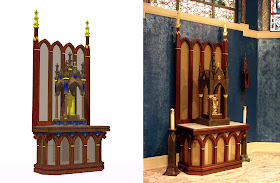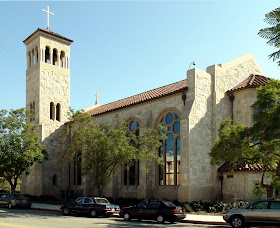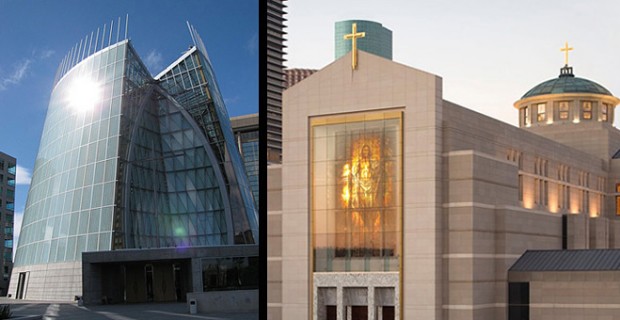For instance: here is the tabernacle canopy and altar of repose designed for St Paul Catholic Church in Pensacola FL, with the original Sketchup illustration and the final furnishings built by Gary Garner (wood altar) and Brian Donahue (bronze canopy, tabernacle lamp, and cast finials).
A series of lovely angel faces, executed in porcelain and mother of pearl, made by Joan DiStefano Ruiz, fill the tops of the lancet arches to support the tabernacle base.
In the past 10 years the developments in computer-based three dimensional design and communication have brought amazing horsepower into the hands of the small businesses, artisans, and hobbyists at a very affordable price. This has been the fruit of the technological revolution in our present Information Age. But so far, the economical availability of this technology has largely been limited to one- and two-dimensional outputs: data crunching, various sorts of graphic manipulation such as digital imaging, word processing, spreadsheets, CAD systems, and the like. This is all changing with the advent of 3-D printing, which is now being made available to the small user at a very economical price-point, such as the Replicator2 by MakerBot. At the Sketchup BaseCamp in Boulder, Bre Pettis, CEO of MakerBot gave the keynote and introduced the new Replicator2. The video is worth watching.
Deciding to get a 3D printer was an immediate and obvious choice: at about $2200.00, the
ability to present my ideas and help my clients visual the designs in
three-dimensional models was immensely attractive. The Replicator works by heating, melting and layering plastic in 3D space on a build platform that moved up and down (the Z axis) while the heating/extruding "print head" moves along a gantry frame to control the lateral placement (the X and Y axes) -- sort of like a 2D printer puts a dot of color on a specific place on a page in the X-Y plan, but this adds the depth of the Z-axis. The plastic is PLA (Polylactic Acid), which is a corn based, biodegradable plastic that has very good dimensional stability and strength. The plastic is spool loaded as a filament (think of really thick fishing line) that is fed into the heating element to be surgically placed in the model. The plastic comes in wide range of colors.
For my first test, I decided on a household project. One of the sliding closet doors had a broken bottom track guide. It was probably 25 years old, and pretty beat up. I probably could have run down to Home Depot and bought a new one for $7.00, but why not see what this Replicator can do?
I made a quick model of guide in Sketchup, carefully measuring and building the geometry -- this took about 15 or 20 minutes.
As can be seen in the section cut below, the upstands for the door guides are hollow and the screw holes were countersunk in the original piece, so I added these details.
I saved the Sketchup model as in an *.STL format (stereo lithography), which is now included in Sketchup, which is then imported into Makerbot's its own proprietary MakerWare software. MakerWare effortlessly imported the STL model (makerWare has its own proprietary *.thing format), but it was imported in metric, which is easily rescaled with the Scale>"Inches->mm" button. This program takes the Sketchup geometry and creates the 3D horizontal slices instructing the extruder head where to place the melted plastic.
Since my computer was not hooked up by USB to the Replicator2 (in which case, simply go to File>Export>Make It), I exported to *.S3G format for the Replicator2, selecting the PLA material and in medium quality, all easily controlled by the export function menu, and saved to an SD Flash card for the built-in SD card reader. I then turned on the replicator2, went through the set-up procedure to load the filament and level the build platform (very clear and easy to follow instructions in the Owner's manual and on the built in LCD screen), and set the machine to print.
Here is a sequence of photos showing the way the foot print is first laid down in melted plastic, then slowly built up layer by layer.
The whole process on "medium quality" (think of this as "resolution" in a 2D image) took 56 minutes to build. Here's some video of the Replicator2 in action:
Here are some photos comparing the original to the new piece.
And the new piece installed:
The bottom line is that affordable 3D printing is a gamechanger for small design firms, and hobbiests. The PLA can be even used in lost wax casting to make molds for poured metals such as bronze, gold, copper, aluminum, tin, silver, and white metals. The quality right off the printer is certainly acceptable for many uses (I have not yet experimented with the high quality setting) and the plastic can be further worked with filling and sanding to achieve a higher level finish if needed. We can assume, just as dot matrix was once the state of the industry, that resolution and speed will only improve over time.
The most important thing is that this sort of technology opens up economic opportunity for all sorts of custom building of spare parts and one-off designs. I wouldn't be surprised if in the next decade these sorts of 3D printers are as almost as common in small businesses and homes as now virtually everyone has 2D printers that produce high quality photo images.
The most important thing is that this sort of technology opens up economic opportunity for all sorts of custom building of spare parts and one-off designs. I wouldn't be surprised if in the next decade these sorts of 3D printers are as almost as common in small businesses and homes as now virtually everyone has 2D printers that produce high quality photo images.
The next Industrial Revolution may just be small scale, home based micro businesses.















































